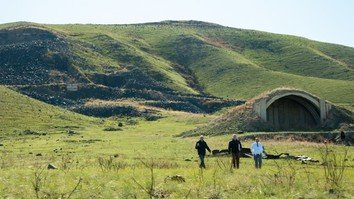KURCHATOV, Kazakhstan -- A US-Kazakh joint programme to reduce the threat of nuclear proliferation has gone on more than a quarter-century, the US Embassy in Kazakhstan said in a statement October 31.
The Defence Threat Reduction Agency (DTRA) is the US agency helping carry out that long-time mission.
The effort at the former Semipalatinsk Test Site (STS) in Kazakhstan is an example of the DTRA's non-proliferation work around the world. Semipalatinsk is called Semey today.
The STS was founded in 1947 during the birth of the Soviet nuclear programme. It covers almost 18,000 sq. km of eastern Kazakhstan.
From 1949 through 1989, the Soviet Union conducted 456 nuclear tests at the STS, without regard for the local population or environment.
After the Soviet Union collapsed in 1991, the scientists and troops who abandoned the STS left behind a complex of tunnels and boreholes, as well as unguarded nuclear materials that presented a significant risk of proliferation.
The Soviets even left a "cancelled nuclear test ... in a tunnel for a number of years until they [Kazakh authorities] could figure out what to do with it", said Luke Kluchko, a project manager for the US Defence Nuclear Agency, which later became the DTRA.
Scarred by a history it did not choose, Kazakhstan had "very strong non-nuclear sentiment", said Kluchko.
Sealing 181 nuclear test tunnels
Kazakh authorities had a formidable task ahead in cleaning up the STS. They created the National Nuclear Centre (NNC) in May 1993.
"It was necessary to eliminate the infrastructure of nuclear weapons testing," said NNC General Director Yerlan Batyrbekov. "It was necessary to resolve the issues associated with eliminating the consequences of testing such weapons."
One task was sealing the STS's 181 nuclear test tunnels, recalled Kluchko. "We ... did about 60 tunnels per year. Essentially within 36 months, we were able to complete the infrastructure elimination process."
"After the elimination of the infrastructure, there were other goals, specifically the elimination of the consequences of nuclear testing," said Batyrbekov.
That work now includes a radiological survey of the STS. NNC personnel, in surveying the STS's expanse, found areas where nuclear material remained in concentrations that presented a risk of proliferation.
The DTRA teamed up with the NNC to eliminate that risk. In 2013, they surveyed the Experimental Field, where the earliest nuclear tests occurred.
"Initially, material left behind from some of the atmospheric or surface tests remained evenly dispersed on the surface," said Mark Gibson, programme manager for DTRA activities at the STS. "In some cases, we could dig up these concentrations and take to secure storage off-site. In other cases where it was less concentrated, we’'d plow the areas and further dilute it so it would be less easily detectable for someone looking."
Praise for US-Kazakh co-operation
Batyrbekov praised the work done by the NNC alongside DTRA.
"DTRA is probably one of our biggest partners in the entire history of the National Nuclear Center, not only in terms of the financial support we receive but also in terms of the significance of the projects that we implemented," he said.
The NNC has radiologically surveyed more than 70% of the STS by now and expects to finish by 2021, said Batyrbekov.
"I give a lot of credit to Kazakhstan for embracing a non-proliferation regime in circumstances that were not ideal for them," said Gibson. "I think our work at the Experimental Field has been an extension of making the world a safer place."

![Members from the Defense Threat Reduction Agency (DTRA) and the National Nuclear Center (NNC) walk from tunnel closure areas on Degelen Mountain at the Semipalatinsk Test Site in eastern Kazakhstan on September 23. [DTRA]](/cnmi_ca/images/2019/11/04/20721-5859706-585_329.jpg)






